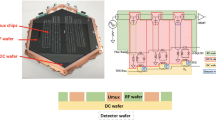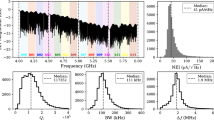Abstract
The Simons Observatory is a ground-based cosmic microwave background instrument to be sited in the Atacama Desert in Chile. SO will deploy 60,000 transition-edge sensors (TES) bolometers in 49 separate focal-plane modules across a suite of four telescopes covering three dichroic bands termed low frequency (LF), mid-frequency and ultra-high frequency. Each MF and UHF focal-plane module packages 1720 feedhorn-coupled detectors with cryogenic components for highly multiplexed readout using microwave SQUID multiplexing. In this paper, we describe the testing program we have developed for high-throughput validation of modules after they are assembled. The validation requires measurements of the yield, saturation powers, time constants, noise properties and optical efficiencies. Additional measurements will be performed for further characterization as needed. We describe the methods developed and demonstrate preliminary results from the initial testing of a prototype module.



Similar content being viewed by others
Data Availability
The data that support the findings of this study are available from the corresponding authors, YW and KZ, upon reasonable request.
Notes
The Bluefors DR has small differences from the others; in what follows, we focus on the Oxford systems for concreteness.
References
The Simons Observatory Collaboration. JCAP 02, 056 (2019). https://doi.org/10.1088/1475-7516/2019/02/056
B. Dober et al., Appl. Phys. Lett. 118, 062601 (2021). https://doi.org/10.1063/5.003341
The Simons Observatory Collaboration. BAAS 51, 147 (2019), arXiv:1907.08284
N. Galitzki et al., SPIE Proc. 10708, 1070804 (2018). https://doi.org/10.1117/12.2312985
H. McCarrick, E. Healy et al., ApJ 922, 38 (2021). https://doi.org/10.3847/1538-4357/ac2232
M.S. Rao, M. Silva-Feaver et al., J. Low Temp. Phys. 199, 807–816 (2020). https://doi.org/10.1007/s10909-020-02429-y
S.W. Henderson et al., SPIE Proc. 10708, 1070819 (2018). https://doi.org/10.1117/12.2314435
Z. Xu, G.E. Chesmore et al., Appl. Opt. 60(4), 864–874 (2021). https://doi.org/10.1364/AO.411711
P.A.R. Ade, G. Pisano, C. Tucker, S. Weaver, SPIE Proc. 6275, 62750U (2006). https://doi.org/10.1117/12.673162
K.D. Irwin, G.C. Hilton, Top. Appl. Phys. 99, 63 (2005). https://doi.org/10.1007/10933596_3
R.V. Sudiwala, M.J. Griffin, A.L. Woodcraft, J. Infrared Millim. Terahertz Waves 23, 545–573 (2002). https://doi.org/10.1570/5.826900
K.T. Crowley et al., SPIE Proc. 9914, 991431 (2016). https://doi.org/10.1117/12.2231999
S.K. Choi et al., J. Low Temp. Phys. 193, 267–275 (2018). https://doi.org/10.1007/s10909-018-1982-4
M. D. Niemack. Towards dark energy: design, development, and preliminary data from ACT. Ph.D.Thesis, pp 110–118 (2008)
N.F. Cothard et al., SPIE Proc. 11453, 11453185 (2020). https://doi.org/10.1117/12.2575912
Acknowledgements
This work was supported in part by a grant from the Simons Foundation (Award 457687, B.K.) and private funding from universities. SKC acknowledges support from NSF award AST-2001866. YL is supported by KIC Postdoctoral Fellowship. ZBH is supported by a NASA Space Technology Graduate Research Opportunities Award. ZX is supported by the Gordon and Betty Moore Foundation through grant GBMF5215 to the Massachusetts Institute of Technology.
Author information
Authors and Affiliations
Corresponding author
Additional information
Publisher's Note
Springer Nature remains neutral with regard to jurisdictional claims in published maps and institutional affiliations.
Rights and permissions
Springer Nature or its licensor holds exclusive rights to this article under a publishing agreement with the author(s) or other rightsholder(s); author self-archiving of the accepted manuscript version of this article is solely governed by the terms of such publishing agreement and applicable law.
About this article
Cite this article
Wang, Y., Zheng, K., Atkins, Z. et al. Simons Observatory Focal-Plane Module: In-lab Testing and Characterization Program. J Low Temp Phys 209, 944–952 (2022). https://doi.org/10.1007/s10909-022-02870-1
Received:
Accepted:
Published:
Issue Date:
DOI: https://doi.org/10.1007/s10909-022-02870-1




